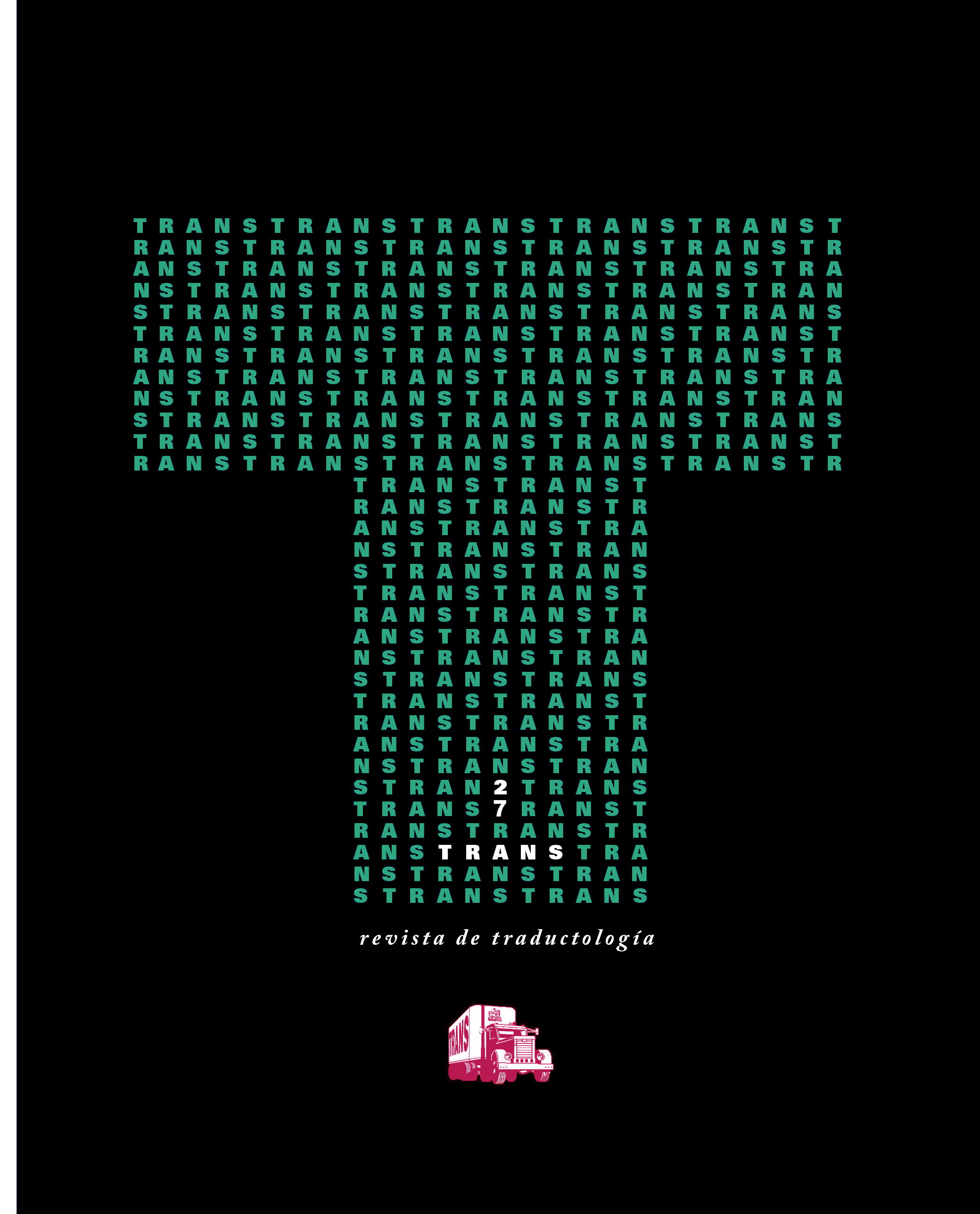Contemporary Arabic Literature through its Covers: an Analysis from the Visual Rhetoric
DOI:
https://doi.org/10.24310/trt.27.2023.16196Keywords:
visual rhetoric, covers, design, Arabic literature, translationAbstract
It is well known that the purpose that serves a book’s cover is double: to offer an overall idea of the content of the work and to attract potential clients by means of its design. In the field of translated foreign literature, the cover element plays an even more key role, since it catalogues the work contained, determines the reading mode, predisposes, or prejudges. The aim that pursues this paper is to revise the Arabic literature translated into the co-official languages of Spain during the last twelve years through some of their covers and to reflect on the editorial design trends, the influence exerted or not by the collective imaginary in the design process and the consolidation, change, or renewal of the stereotypes, images, and symbols linked to this literature.
Downloads
Metrics
Publication Facts
Reviewer profiles N/A
Author statements
Indexed in
-
—
- Academic society
- N/A
- Publisher
- Universidad de Málaga
References
Al Azzawi, D. (1978). Watching Others [Imagen]. Dalloul Art Foundation. https://dafbeirut.org/en/dia-al-azzawi/works/232660-watching-others.
Albaladejo, T. (2013). Retórica cultural, lenguaje retórico y lenguaje literario. Tonos Digital, 25, 1-21. http://www.tonosdigital.com/ojs/index.php/tonos/article/view/974/622.
Blair, S. S. (2007). Islamic Calligraphy. Edinburgh University Press.
Castro y Serrano, J. (15 de diciembre de 1887). Joyas moriscas. La Ilustración española y americana, 46, 358-359. https://www.cervantesvirtual.com/obra/la-ilustracion-espanola-y-americana--1455/.
El-Ariss, T. (2006). Palestine in the persistence of memory [Reseña de Gate of the Sun, de Elias Khoury]. Banipal, 25. https://www.banipal.co.uk/book_reviews/14/gate-of-the-sun-by-elias-khoury/.
Espinar Moreno, M. (2019). Las joyas en el islam: reflexiones sobre arqueología y artes menores. Libros EPCCM. http://hdl.handle.net/10481/55444.
Even-Zohar, I. (1999). La posición de la literatura traducida en el polisistema literario (Trad. M. Iglesias Santos). En M. Iglesias Santos (Comp.), Teoría de los Polisistemas (pp. 223-231). Arco/Libros.
Fernández Iñurritegui, L. y Herrera Fernández, E. (2016). Diseño de cubiertas de libros: recursos de retórica visual. Síntesis.
Franco Mata, Á. (2014). Sistemas de acopio de arte medieval en grandes museos. Boletín del Museo Arqueológico Nacional, 29-31 (2011-2013), 65-106. http://www.man.es/man/estudio/publicaciones/boletin-man/2010-2019/2013-29-franco.html.
Genette, G. (1997). Paratexts: Thresholds of Interpretation (J. E. Lewin, Trad.). Cambridge University Press.
Ibn Hazm, A. M. A. (2022). El collar de la paloma (E. García Gómez, Trad.). Red Ediciones.
Li, C. (2019). Diseño editorial, Retórica cultural e imaginario colectivo: cubiertas de libros de literatura contemporánea china en España. Dialogía, 13, 39-83. https://journals.uio.no/Dialogia/article/view/7648.
Lister, M. y Wells, L. (2001). Seeing Beyond Belief: Cultural Studies as an Approach to Analysing the Visual. En T. van Leeuwen y C. Jewitt (Eds.), Handbook of Visual Analysis (pp. 61-91). SAGE.
Mahyub Rayaa, B. y Gutiérrez Almenara, A. (2021). Arabic Literature Translation into the Co-Official Languages of Spain (2010-2020). Literature Across Frontiers y Anna Lindh Foundation. https://www.lit-across-frontiers.org/wp-content/uploads/2013/03/SPAIN-Arabic-Lit-Translation-2021-2.pdf.
Mamduh, A. (2000). Naftalina (I. Gutiérrez, Trad.). Ediciones del Oriente y del Mediterráneo.
Marin-Lacarta, M. (2014). Reclamos reiterativos en las traducciones de literatura china moderna y contemporánea en España. En G. García-Noblejas Sánchez-Cendal (Ed.), Estudios de traducción e interpretación chino-español (pp. 57-101). Universidad de Granada.
Morris, E. K. (s.f.). Lot Essay. Christie’s. https://www.christies.com/en/lot/lot-4693745.
Paradela Alonso, N. (2001). «Así que esto es el hammam…». Revista de Libros, 49, 33-34. https://www.revistadelibros.com/naftalina-novela-de-alia-mamduh/.
Peña Martín, S. (2020). La Shahrazad fantasmática: distorsión y traducción de las Mil y una noches en el ámbito hispánico. Hermēneus: Revista de Traducción e Interpretación, 22, 271-310. https://doi.org/10.24197/her.22.2020.271-310.
Ramírez Louit, M. (2021). La conexión pintura-poesía, en las cubiertas del artista Víctor Ramírez para la Colección de poesía Vaso Roto. Barcelona, Research, Art, Creation, 9 (3), 347-354. https://doi.org/10.17583/brac.8297.
Ramírez, V. (s.f.). Grabados y dibujos de la exposición «Vaso Roto». https://victorramirez.art/grabados-y-dibujos-de-la-exposicion-vaso-roto/.
Sciberras, K. (2009). Tres cuadros de Francesco Noletti en el Museo de Bellas Artes de Bilbao; Merino Gorospe, J. L. Estudio analítico y estilístico para una aproximación a su técnica. B’08: Buletina = Boletín = Bulletin, 4, 129-194. https://bilbaomuseoa.eus/media/2021/12/abrir-pdf-espanol-1-60-mb.pdf.
Serra-Vilella, A. (2022). “No podía ser más nipón”: imagen del otro en las traducciones al español de Confesiones de una máscara de Mishima. TRANS: Revista de Traductología, 26, 141-159. https://doi.org/10.24310/TRANS.2022.v26i1.14068.
Villiers, A. (1940). Sons of Sindbad. Hodder and Stoughton.
Villiers, A. (2006). Sons of Sindbad: The Photographs. National Maritime Museum. (Trabajo original publicado en 1940).
Downloads
Published
How to Cite
Issue
Section
License
Copyright (c) 2023 Angelina Gutiérrez Almenara

This work is licensed under a Creative Commons Attribution-NonCommercial-ShareAlike 4.0 International License.
All contents published in TRANS. Revista de Traductología are protected under the Creative Commons Attribution-NonCommercial-ShareAlike 4.0 International (CC BY-NC-SA 4.0) license. All about this license is available in the following link: <http://creativecommons.org/licenses/by-nc-sa/4.0>
Users can copy, use, redistribute, share and exhibit publicly as long as:
- The original source and authorship of the material are cited (Journal, Publisher and URL of the work).
- It is not used for comercial purposes.
- The existence of the license and its especifications are mentioned.
- ShareAlike — If you remix, transform, or build upon the material, you must distribute your contributions under the same license as the original.
There are two sets of authors’ rights: moral and property rights. Moral rights are perpetual prerogatives, unrenounceable, not-transferable, unalienable, imprescriptible and inembargable. According to authors’ rights legislation, TRANS. Revista de Traductología recognizes and respects authors moral rights, as well as the ownership of property rights, which will be transferred to University of Malaga in open access.
The property rights are referred to the benefits that are gained by the use or the dissemination of works. TRANS. Revista de Traductología is published in an open access form and it is exclusively licenced by any means for doing or authorising distribution, dissemination, reproduction, , adaptation, translation or arrangement of works.
Authors are responsable for obtaining the necessary permission to use copyrighted images.













21.png)
